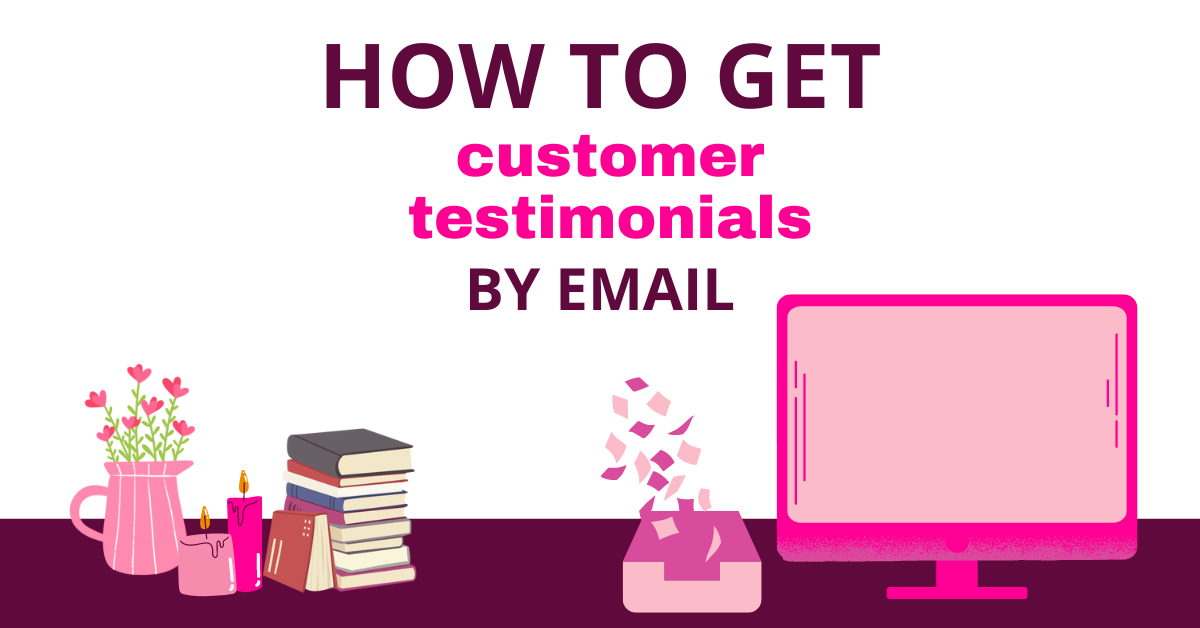How To Get Customer Testimonials By Email

Customer testimonials are powerful. They help to give your small business credibility, and they’re an effective way for potential customers to more easily make purchasing decisions from you, because they can see you already have satisfied customers.
There are many ways to collect customer testimonials, but one way that is often overlooked is to ask for testimonials/reviews from your customers by email.
In this post I’ll talk about why you should collect positive reviews from new customers and loyal customers, why you should have strategy to do this via email, and the best way to connect with happy customers via email to encourage them to give you customer feedback, and leave you an honest review.
There are different ways you can ask your customers to give you testimonials/reviews, and I’ll cover three easy and free options you can use via email in this post:
1. Ask for reviews via email, asking people to reply.
2. Ask for reviews via email and link to reviews on a google business page.
3. Ask for reviews via email and link to a Google feedback form.
STARTING STEPS
To send an email asking for customer reviews, you’ll first need to have an email list set up, and you’ll need to make sure that when any customers purchase products or services, they are added to your mailing list, so that you can then send an email out to them to ask for a review.
If you need to learn more about mailing lists for your small business, check out the following blog posts:
WHERE TO START A MAILING LIST FOR FREE
HOW TO DRIVE PEOPLE TO YOUR MAILING LIST
It’s important to make giving you a review as easy as possible, and it’s also good practice to offer your customers an incentive (such as a discount code off their next purchase or gift cards for example), in return for them taking time to give you an honest testimonial/review.
Start by thinking about what you’re prepared to offer in exchange for reviews, as you may well find you’ll receive more reviews if you incentivise people to leave you a consumer review.
Don’t underestimate the power of great reviews. They show people that you’re a legitimate business, that your products and services are worth purchasing, and they help give you credibility in the online space.

CHOOSE HOW YOU’LL ASK FOR CUSTOMER TESTIMONIALS
You’ll send an email out to customers who have purchased from you, and I’ll cover when and how you should do that below.
But you should first decide the way in which you’ll ask your customers to give you a review.
When you send your email out, you can either:
1. Ask your customers to give client testimonials by replying to your email. I would suggest that this is probably the least effective way, and you might find people are more willing to fill out a pre-made testimonial form that you create on a platform like Google, or leave you a review on your Google Business Page. I cover both of those methods below.
However, there’s nothing to stop you testing this way of asking for testimonials, and the benefit of this method is that if anyone does reply to your email, you can then immediately let them have some sort of discount code or gift voucher by way of a return email to them, to thank them for their time and effort.
2. You can send an email out to ask people for a review, and to link them to the reviews section of your Google Business Page if you have one set up.
If you’re a small business in the online space you should have a Google Business Page. It’s free to set up and contains a wealth of information about your small business.
Having a Google Business Page can also help you rank for Google SEO. Your Google Business Page has a reviews section that’s a testimonial page anyone can go to, to leave consumer reviews.
When you have your Google Business Page set up, you can use a link for the reviews section on your Google Business Page, and drop that link inside the email you send to your customers asking for product reviews or customer testimonials.
The more reviews you have on your Google Business Page the more it helps with SEO for your Google Business Page. This helps your business be found on Google. If you need help setting up your Google Business Page, and to learn about everything your Google Business Page can do to help drive traffic to your business, click here for a free Google Business Page training.
3. You can also create testimonial templates inside Google Drive. If you have a google gmail account you’ll find a feature inside your Google account called forms. It’s easy to create a testimonial form and to get a link to the form that you can drop in an email to send to your customer/clients, to ask for customer reviews/testimonials. To learn how to create a Google testimonial form for your small business click here.
There’s nothing wrong with switching between any of the above three options to ask for customer reviews by email, but only use one option in each email, so that you’re not confusing your audience.
HOW AND WHEN YOU SHOULD SEND YOUR EMAIL TO ASK FOR A CUSTOMER REVIEW
Let’s move on to look at the best time to send an email to ask for a customer review in a nice way, and the right questions you should ask to get a good testimonial.
There’s a right time and a wrong time to send out your email customer review requests. Part of this process involves making sure you have an email automation set up with your mailing list provider, so that you can set a date and time to send your testimonial request email out. Setting up an email automation for customer reviews is an easy way to take care of asking for your customer testimonials.
What you’ll need to take into account when sending an email with a testimonial/review request, is the date/time that the customer will receive any purchases they have made from you, and to then give your customer time to use or absorb the product/service they have purchased before you ask for customer feedback.
If you send your email out too early and the customer has not received the item purchased or had time to absorb/use what they have purchased, you’ll likely not get any responses and your email will be forgotten by the time customers have used what they’ve purchased from you.
If you send the testimonial email out too late, the customer may have already forgotten about their purchase, or no longer be invested enough to give you a review.
The best time to send out an email customer review request is between 7-30 days after the buyer journey has been completed.
That means if your customer purchases a product from you that they can use immediately, it makes more sense to ask for a positive testimonial around 7 days after they will have received the item. However, if your customer has purchased a training course from you for example, and they need time to invest in that training, dependent on the length of the training they have purchased, your email testimonial request could be sent out anywhere from 7 to 30 days.
You have to judge the timing, and use best practices in terms of when your customer will have had opportunity to use/learn from the product/service they’ve purchased. So don’t send your testimonial request too early, or too late.
Before you send your email customer testimonials requests out, be sure to have sent some other emails to your customer/client first.
This helps create a positive experience with your customer before you start asking them to do something for you. You could send an email welcome nurture sequence out to the people who purchase your products/services as a starting point to help forge relationships with people who have joined your list.
You can click here to read my blog post “7 Tips To Create A Winning Email Nurture Sequence“.
Your email nurture sequence is a great way to build more know, like and trust with your customer base before you start asking for a review.
You should then set up a second email automation that is your email sequence asking for a review. Choose the best time to send that email out as set out above.
You can send more than one email out as part of your testimonial email requests, to encourage your customers to respond. People need to be reminded. So I’d suggest 3 emails in your testimonial email request sequence – the first email that asks for a product review, and two further email reminders, spread 3 days apart.
The testimonial collection process is not always easy. It depends how invested in you and your business your customers are, and of course the type of customer experience they’ve had with you.
THE CONTENT OF YOUR EMAIL TESTIMONIAL REQUEST
When crafting your emails to send out to ask for customer reviews, always choose a great subject line for the email.
You want something that stands out, rather than just a generic “would you leave me a review”.
Remember your customer’s inbox is full of emails. You have to figure out how to stand out.
Here are some examples of the type of subject line you can use in your testimonial email requests:
- Can we get a high five from you?
- Help make us even better.
- Help us reach the top!
- £100 for the customer who leaves the most helpful review.
- We’re proud of what we’ve created, can you help us spread the word?
- You’re important and you matter to us!
- Fancy a free gift?
When you send your email out, it’s a good idea to use your customer’s name at the start of your email address, rather than just a generic ‘hi’, or ‘hello’. Using your customer’s name makes the mail more personal to them, and will help them move into the body of the email where you ask for a review.
Your goal in the email is to get your customers to take action. You need to let them know you value them as a customer/client, to express that you hope they’re happy with their purchase, to let them know you recognise they’re busy, and ask whether they would be kind enough to leave you a review.
You can share some images of other customer reviews in the email to a flavour of what they could say (people sometimes struggle to know what to say in a review, and therefore don’t do one), and you can make reference to any coupon code or special offer or gift they’ll receive if they provide a written testimonial.
Most importantly you need to tell people how they can easily leave you a customer review. So if you choose to capture reviews by return of email you would simply say ‘just reply to this email to leave your review’. If you’re asking for reviews by pushing people to your Google Business Page, or via a Google form you’ve created, you should drop the clickable link inside the email.
I would not use a qr code in the email to redirect people to somewhere to leave a review, as they’re likely to be reading your email on a mobile device, and clicking a link is easier.
Remember if you ask people to reply to your email or to go to a Google Business Page to leave a customer review, you’re leaving it up to the individual to create that testimonial/review.
If you use a pre-designed Google Form, you’re able to craft questions to direct what sort of feedback you want from your customers, and we’ll cover that below.

LIST OF QUESTIONS
If you’re asking for customer reviews using a Google form, you’ll need to set that form up. You can do that inside your Google dashboard, using the forms facility.
In that space you can create any number of customer feedback forms for different products/services in your business if you wish. But keep it simple to start.
Create a Google form that asks open-ended questions rather than simple yes or no answers. Alternatively, you can set up your Google form so that you are asking customers to write their own review, rather than answer questions you’ve created. The benefit of the second way, is you can easily copy and paste the customer reviews anywhere you wish them to appear.
If you’re asking lots of pre-formed questions, it’s more difficult to copy/paste those responses across your brand to use as social proof. Also, if you are going to ask questions, make sure you keep the number of questions to a minimum. The more you ask, the less likely people will complete them all.
If you’d like to learn how to easily set up a Google Form for free that you can use to capture customer reviews/testimonials, click here. You’ll go straight to a 20 minute video showing you the entire process.
RESPONSE RATE
The response rate for customer reviews can be low, and it can take time to build a good stock of reviews for your business.
However, every online review you can get counts. Keep those reviews safe, and know that you can share them anywhere you wish online to help build social proof for your business in the online space. Reviews and testimonials are a powerful tool to help give your small business real credibility in the online space.
TESTIMONIAL VARIATIONS
Your customer reviews do not just have to be in written form. Asking people for video testimonials adds further credibility to your business. I did this when I launched my UNSTOPPABLE Club for female small business owners.
I gave all ladies who wanted to sign up to my initial launch of UNSTOPPABLE Club the opportunity to send me a testimonial video that I could pop on my sales page, in return for a slightly reduced membership to UNSTOPPABLE Club. It worked. I got around 15 video testimonials off the back of that offer. It’s likely you’ll have to offer some incentive to get positive feedback through video testimonials.
FOLLOW UP WITH A THANK YOU AND LET PEOPLE KNOW THEY’VE BEEN A HUGE HELP
When anyone leaves you a customer review, always follow up with a personalised thank you to let your customer know they’ve been a huge help in taking time to provide you with online reviews for your small business. This helps the customer feel they are valued, and it’s likely they will continue to stick around.
GREAT TESTIMONIALS CAN BE THE KEY TO HELPING YOU GROW ONLINE, SHARE THEM EVERYWHERE
All types of testimonials and positive reviews are great for your small business. Whilst this post is about capturing testimonials via emails, you can also ask for customer reviews everywhere else you’re visible.
You can have cta buttons in the bios of your social platforms, links that you drop at the bottom or in the side bar of your blogs, links in your podcast descriptions, scannable QR codes that you put on business literature and stationery that you send out to purchasers of your products and services, QR codes in the banners on your facebook pages or groups, your marketplace platforms, your youtube channels.
IN SUMMARY
Good email testimonial requests sent at the right time to customers/clients who have purchased your products or services can be an easy way to add customer reviews/testimonials to your business.
Remember to save any testimonials you receive. Screenshot them, save them to a folder and use them across your small business – including on sales pages, your website home page, your blog, your business literature.
When I’ve received customer reviews I’ve kept screenshots in a folder on my laptop. I’ve then uploaded them to Canva and dropped them on brand colour designs, so that I can use them as social proof on my social platforms, as credibility on my website pages, sales pages, and to put in blogs, and in podcast descriptions.
There’s a right way to ask for customer reviews/testimonials via email, and the above covers a range of valuable tips to help you craft better email customer review requests for your small business. Be sure to set up and use automated emails to ask for reviews/testimonials from your customers whenever they purchase products or services from you. Use any reviews you receive across your small business to help bring more credibility to your brand.
When you’re ready to go deeper, and to take you small business to greater success in the online space, to become unstoppable in your small business, maximise your results and limit daily stress, anxiety and struggle, start by choosing one of my free small business guides below (note: you should choose both – they each have great value!).
Jenny


